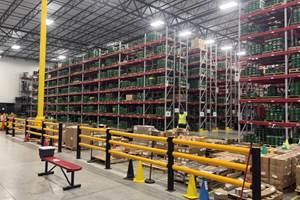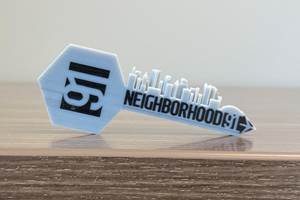Spring 2024 TRX Showcases Projects Designed to Drive Additive Manufacturing Advancement
The America Makes TRX platform promotes exploration with more than 30 highlighted projects that are designed to propel the additive manufacturing industry.
Joy Gockel from the Colorado School of Mines was a keynote speaker and spoke on Interdisciplinary Research and Education in ADAPT at Mines. Source: America Makes
America Makes hosted its spring Technical Review and Exchange (TRX) event in early April at the Colorado School of Mines in Golden, Colorado. The three-day event brought together hundreds of engineers, decision-makers, government officials, members and partners across the additive manufacturing (AM) industry, showcasing more than 30 projects along with the Institute’s growth and achievements.
“America Makes is here to serve as the voice of the AM industry,” says Brandon Ribic, technology director at America Makes. “We are working with those in industry and academia, the national lab network and even beyond the Department of Defense (DOD) to understand the technical attributes to change our current state.”
During TRX@Mines, keynote speakers delivered technical discussions sharing their expert perspectives, including Zhenzhen Yu and Owen Hildreth from the Colorado School of Mines, Ryan Ott from the Ames National Laboratory, and Callie Higgins and Nik Hrabe from the National Institute of Standards and Technology (NIST).
As with previous events, this year’s conference enabled members to look deeper at the Institute’s work, offering insights into some of AM’s biggest challenges and growth opportunities. In addition to research and development updates, the event was a knowledge hub for industry leaders to network and share innovative approaches across design, material, process and value chain, operations and more.
Metal AM Process and Material Advancements
Controlling variability and monitoring material properties and microstructure emerged as headlining topic areas. As Hrabe said in his keynote, current challenges such as a limited understanding of powder properties, unclear measurement techniques and varying reproducibility of different powder metrics are pervasive barriers hindering standard protocols for powder measurement techniques across equipment manufacturers.
NIST’s latest process monitoring developments across metal build part irregularities focused on fatigue and fracture behavior in critical applications to address these gaps. Hrabe asserts the industry is realizing a greater understanding of these processes. “I think as a community we’re getting better at printing parts that, when possible, can have minimal defects, and rough surfaces or internal pores no longer drive component failure,” Hrabe says.
To date, Hrabe and the NIST research team have accomplished the following:
- Discovered new sources of variation in AM titanium and developed effective mitigation strategies.
- Led the development of two new ISO/ASTM standards for design guidelines and powder handling.
- Pioneered a novel fatigue-resistant AM titanium microstructure and introduced a cost-effective process control technique to enhance fatigue performance.
- Enabled the first-time use of AM titanium in critical medical device applications.
- Devised a resonant acoustic technique for speedy, cost-effective, nondestructive evaluation of AM parts.
In further material development, Ott highlighted progress in developing refractory alloy powders for AM and the current industrialization challenges and opportunities. Utilizing data from existing oxide dispersion strengthened (ODS) methodologies, Ott says he and his team at Ames National Laboratory have seen incremental successes in developing high-performance aluminum alloys with higher melting temperatures, potentially foreshadowing significant advancement toward commercialization.
“We are trying to fill that tech gap using nuclear fusion, and we hope to leverage the capabilities and the expertise to translate that fundamental discovery science into that commercial adoption,” Ott says.
Areas of Focus for Qualification and Standardization
TRX@Mines highlighted the significance of qualification and standardization in hastening AM adoption in aerospace and defense. Delta qualification projects echoed the need for a standardized approach to AM to ensure quality, reliability, and safety.
Among the current six active projects, The Ohio State University Center for Design and Manufacturing Excellence’s Ben DiMarco, project leader, urged engineers to embrace new ideas while discussing the project for “Rapid Qualification Pathway for Metal Additive Manufacturing using Laser powder bed fusion (LPBF) for Critical Applications” in partnership with EOS. DiMarco's team has developed a data fusion approach that leverages optical cameras, tomography sensors and machine data to streamline the metal AM process. By utilizing these cutting-edge technologies, the team is positioned to create a faster and more flexible data-driven framework that can be used across multiple machines to increase supply chain efficiency. The results of this project could revolutionize the field of metal AM.
Similarly, Zack Simkin of Senvol discussed his team's project focusing on material allowables for qualification. Senvol and its team devised an approach to developing a material design that leverages machine learning (ML) algorithms. Senvol's ML approach analyzed numerous changing parameters simultaneously within the topic area’s scope, noting each parameter’s marginal contribution. The research teams’ efforts indicated a viable alternative to conventional “point solution” methods, opening the door for a more economically feasible and flexible approach. Furthermore, it substantiated that data-driven ML algorithms could significantly reduce the cost of material design allowable development. This approach leads to a greater understanding of optimal solutions to overcome the qualification and requalification challenges that slow the expansion of this industry.
Casting and Forging
AM’s potential to improve the casting and forging (C&F) sector was noted as several presenters demonstrated new findings as part of America Makes multiyear technology C&F road map. Brady Williams, from Wichita State University National Institute for Aviation Research, and Mayank Garg, from Cleveland State University, addressed several road map areas while offering attendees a deeper look into AM's enhancing potential for the C&F sector.
Honeywell's Greg Colvin presented findings from the project “Transitioning Best Practices and Technical Improvements for 3D Printed Molds/Cores for Sand Castings.” In partnership with ExOne, Hoosier Pattern, Ohio Aluminum and Chicago Magnesium, Colvin discussed the team’s effort to improve the casting quality of parts produced with AM sand molds and cores. The project aims to reduce porosity, improve surface roughness and minimize dimensional variations with findings disseminated to the industry. In addition, the American Foundry Association (AFS) is developing training materials and courses to promote innovative solutions for small and medium-sized foundries.
Latest Project Call
America Makes also continued its commitment to expanding the C&F industry as John Martin, research director, announced the Institute’s latest project call worth $6.6 million. The project, “Improvements in Manufacturing Productivity via Additive Capabilities and Techno-Economic Analysis 2.0 (IMPACT 2.0),” aims to showcase improvements in lead time, productivity and yield for C&F manufacturing operations.
AM Innovation Driven by Collaboration
TRX@Mines also highlighted the critical components for unlocking the full potential of AM as a revolutionary technology — unconventional thinking, exploration and collaboration. As Ribic notes, “There is more to do, but to that point, we have to address what we don’t know and the unknowns.”
With that focus, the group is reintroducing America Makes’ CORE, the Institute’s digital information hub to help foster collaboration and provide reliable information on the latest datasets for members to access. This move is intended to facilitate increased partnerships and information sharing, ultimately leading to the acceleration of the AM industry.
To view the content presented at TRX, please visit the America Makes Spring TRX Presentation Content.
Related Content
Variable Resistance Valve Trim Achieves Lead Time Reduction Through AM: The Cool Parts Show #69
Baker Hughes is realizing shorter lead times and simplified manufacturing through powder bed fusion to produce valve trims previously assembled from many machined metal parts.
Read MoreThis Year I Have Seen a Lot of AM for the Military — What Is Going On?
Audience members have similar questions. What is the Department of Defense’s interest in making hardware via 3D printing over conventional methods? Here are three manufacturing concerns that are particular to the military.
Read MoreDo Distributors Dream of Digital Inventory? Würth Additive Group Does
It’s more than a dream for Würth Additive Group and its parent company, in fact. Along with supplying additive equipment, the group is now developing solutions for sourcing 3D printed parts in a reliable, elastic digital inventory model.
Read MoreWhat Is Neighborhood 91?
With its first building completely occupied, the N91 campus is on its way to becoming an end-to-end ecosystem for production additive manufacturing. Updates from the Pittsburgh initiative.
Read MoreRead Next
3D Printed Polymer EOAT Increases Safety of Cobots
Contract manufacturer Anubis 3D applies polymer 3D printing processes to manufacture cobot tooling that is lightweight, smooth and safer for human interaction.
Read MoreCrushable Lattices: The Lightweight Structures That Will Protect an Interplanetary Payload
NASA uses laser powder bed fusion plus chemical etching to create the lattice forms engineered to keep Mars rocks safe during a crash landing on Earth.
Read MorePostprocessing Steps and Costs for Metal 3D Printing
When your metal part is done 3D printing, you just pull it out of the machine and start using it, right? Not exactly.
Read More





















